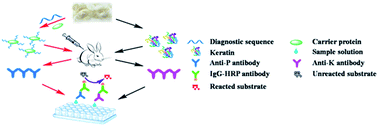当前位置:
X-MOL 学术
›
Anal. Methods
›
论文详情
Our official English website, www.x-mol.net, welcomes your
feedback! (Note: you will need to create a separate account there.)
Preparation of artificial antibodies and development of an antibody-based indirect ELISA for the detection of ancient wool†
Analytical Methods ( IF 2.7 ) Pub Date : 2018-03-03 00:00:00 , DOI: 10.1039/c8ay00015h Bing Wang 1, 2, 3, 4, 5 , Jincui Gu 1, 2, 3, 4, 5 , Qiushi You 1, 2, 3, 4, 5 , Boyi Chen 1, 2, 3, 4, 5 , Hailing Zheng 5, 6, 7, 8, 9 , Yang Zhou 5, 6, 7, 8, 9 , Zhiwen Hu 3, 4, 5, 10
Analytical Methods ( IF 2.7 ) Pub Date : 2018-03-03 00:00:00 , DOI: 10.1039/c8ay00015h Bing Wang 1, 2, 3, 4, 5 , Jincui Gu 1, 2, 3, 4, 5 , Qiushi You 1, 2, 3, 4, 5 , Boyi Chen 1, 2, 3, 4, 5 , Hailing Zheng 5, 6, 7, 8, 9 , Yang Zhou 5, 6, 7, 8, 9 , Zhiwen Hu 3, 4, 5, 10
Affiliation

|
The use of wool from sheep is widespread in ancient and historic textiles. The detection of ancient wool can provide meaningful information for both archaeologists and academics. However, the efficacy of conventional methods is likely to be limited in the detection of ancient samples with severe degradation or contamination. This is also one of the main challenges in archaeological sites. In this study, a novel immunological approach was proposed to overcome this difficulty. Two diagnostic antibodies, the anti-K (keratin) antibody and the anti-P (peptide) antibody, were carefully designed and prepared through the immunization of animals with a complete antigen (keratin) and the conjugation product of hapten (diagnostic peptide) with a carrier protein, respectively. Next, an indirect enzyme-linked immunosorbent assay (ELISA) was established under the optimal binding concentration of the coating antigens and the antibodies. The results indicated that the antibody-based immunological method exhibited high sensitivity, specificity and reliability. The limit of detection in the ELISA for the anti-K and anti-P antibodies was 81.39 ng mL−1 and 6.81 ng mL−1, respectively. The ELISA revealed a lower cross-reactivity (less than 0.01%) for the two antibodies with interference antigens. The recoveries of the two antibodies from standard soil samples were in the range of 80% to 100%, with a relative standard deviation (RSD) of lower than 9%. The coefficients of variation for the anti-K antibody and anti-P antibody were in the range of 3.27% to 12.40% and 9.48% to 10.31%, respectively. Moreover, both the anti-K and anti-P antibodies can positively identify ancient wool samples, even for wool traces in soil, verifying the validity and practicability of the immunological method in the detection of ancient wool.
中文翻译:

人工抗体的制备和基于抗体的间接ELISA的开发,用于检测古羊毛†
在古代和历史悠久的纺织品中广泛使用绵羊毛。古代羊毛的发现可以为考古学家和学者提供有意义的信息。但是,在检测具有严重降解或污染的古老样品时,常规方法的功效可能会受到限制。这也是考古现场的主要挑战之一。在这项研究中,提出了一种新颖的免疫学方法来克服这一困难。通过用完全抗原(角蛋白)和半抗原(诊断肽)的结合产物对动物免疫,精心设计和制备了两种诊断抗体,即抗K(角蛋白)抗体和抗P(肽)抗体。载体蛋白。下一个,在包被抗原和抗体的最佳结合浓度下建立了间接酶联免疫吸附试验(ELISA)。结果表明,基于抗体的免疫学方法具有较高的灵敏度,特异性和可靠性。ELISA中抗K和抗P抗体的检出限为81.39 ng mL-1和6.81 ng mL -1。ELISA显示两种具有干扰抗原的抗体的交叉反应性较低(小于0.01%)。从标准土壤样品中两种抗体的回收率在80%至100%的范围内,相对标准偏差(RSD)低于9%。抗K抗体和抗P抗体的变异系数分别在3.27%至12.40%和9.48%至10.31%的范围内。而且,抗K和抗P抗体都可以肯定地鉴定古老的羊毛样品,即使是土壤中的痕迹羊毛,也证明了免疫学方法在古老羊毛检测中的有效性和实用性。
更新日期:2018-03-03
中文翻译:

人工抗体的制备和基于抗体的间接ELISA的开发,用于检测古羊毛†
在古代和历史悠久的纺织品中广泛使用绵羊毛。古代羊毛的发现可以为考古学家和学者提供有意义的信息。但是,在检测具有严重降解或污染的古老样品时,常规方法的功效可能会受到限制。这也是考古现场的主要挑战之一。在这项研究中,提出了一种新颖的免疫学方法来克服这一困难。通过用完全抗原(角蛋白)和半抗原(诊断肽)的结合产物对动物免疫,精心设计和制备了两种诊断抗体,即抗K(角蛋白)抗体和抗P(肽)抗体。载体蛋白。下一个,在包被抗原和抗体的最佳结合浓度下建立了间接酶联免疫吸附试验(ELISA)。结果表明,基于抗体的免疫学方法具有较高的灵敏度,特异性和可靠性。ELISA中抗K和抗P抗体的检出限为81.39 ng mL-1和6.81 ng mL -1。ELISA显示两种具有干扰抗原的抗体的交叉反应性较低(小于0.01%)。从标准土壤样品中两种抗体的回收率在80%至100%的范围内,相对标准偏差(RSD)低于9%。抗K抗体和抗P抗体的变异系数分别在3.27%至12.40%和9.48%至10.31%的范围内。而且,抗K和抗P抗体都可以肯定地鉴定古老的羊毛样品,即使是土壤中的痕迹羊毛,也证明了免疫学方法在古老羊毛检测中的有效性和实用性。











































 京公网安备 11010802027423号
京公网安备 11010802027423号